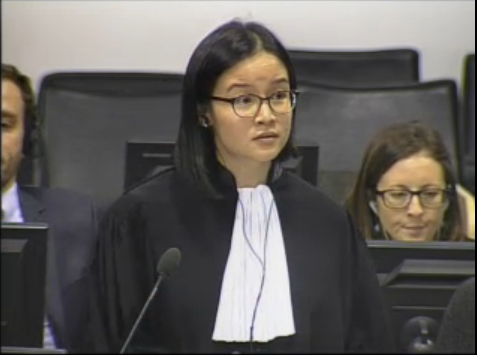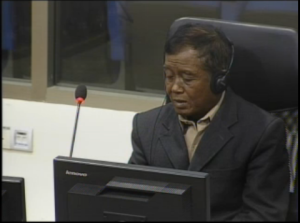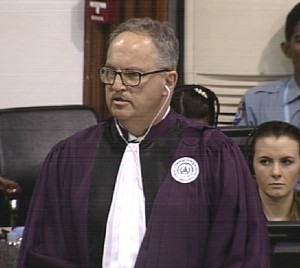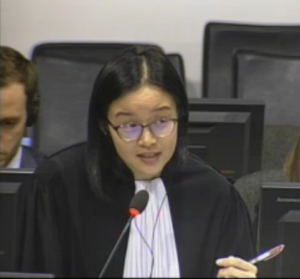Escaped Khmer Rouge Soldier Testifies on Joining Vietnamese-Backed Liberation Army
Today marked the beginning of a new segment at the Trial Chamber: internal purges. Chhun Samorn appeared in Court as a Civil Party today in the second phase of Case 002 against Nuon Chea and Khieu Samphan. Chhun Samorn was enlisted in the Khmer Rouge troops in 1975, when he was only 18 years old. He was a messenger, a soldier and gathered intelligence on Vietnamese troops at the border until 1978, when he escaped after soldiers from the East Zone, like him, were arrested to be executed. At the time, there were occurrences of armed conflicts between Democratic Kampuchea and Vietnam. The witness had then escaped to Vietnam, which is where he became a part of the Liberation Army to fight the Khmer Rouge. Chhun Samorn was interrogated by Civil Parties, the Prosecution, the Chamber as well as the Defense and the questioning was directed towards the notion of a pattern, a policy to eliminate soldiers from the East Zone, close to the Vietnamese border.

Senior Legal Consultant for the Defense of Nuon Chea Doreen Chen cross-examines the Civil Party on Tuesday.
Introduction of the new witness and context
Yesterday, Ms. Anta Guissé of the Khieu Samphan Defense Team summarized a request she had presented to the Court earlier this week. After adjourning for half the day yesterday to deliberate, President of the Trial Chamber Nil Nonn said that the Chamber concluded the question did not pose itself for today’s witness. The Court would issue a detailed ruling “in due course”, he added.
Witness 2-TCCP-236, Chhun Samorn, was ushered into the Courtroom. He looked very intimidated, and answered the President’s preliminary questions with his head down. This marked a sharp contrast with the latest witness, former head of S-21 and war criminal Duch, who was always looking at the whole Courtroom, at-ease and engaged from the first day of his testimony onwards. The fact that Mr. Chhun Samorn is a Civil Party in the case put the Courtroom in a different atmosphere. Moreover, questions by the Lawyers and the Judges proved to be less complex and more straight-forward.
Mr. Chhun Samorn was born in 1957 in Kama village, in Kampong Rou District, Svay Rieng Province. He was a rice farmer. Answering to Civil Party Lawyer Ty Srinna, he told the Chamber that before April 17, 1975, he lived in the village where he was born, with his parents and with his eight siblings. Chhun Samorn joined the ranks of the Kampuchean Army of the East Zone in May 1975. Jien and Soun were part of the leadership in his unit and Kom Sakei was the Chief of Unit K75 in Kampong Rou District. He was a messenger from 1975 to 1976, when he was sent to Sector 23 and was assigned to be a soldier in the Special Unit 73, part of Regiment 112. Ten Sun, alias Pun, was the chief of the regiment. The Special Unit, a mobile unit, was responsible for collecting intelligence information from the enemy.
The Civil Party mostly kept his eyes down, only looking over briefly at Civil Party Lawyer Ty Srinna. He was leaning forward with his shoulders hunched, showing a certain tension. Mr. Chhun Samorn went on to describe that he was sent to the Vietnamese border areas, especially during tense conflict situations with Vietnam, notably in 1976 and in different battlefields such as Bavet, in Kampong Rou District. He recalled that the fighting against the Vietnamese intensified in 1977, and that consequently soldiers from the Central Zone were sent to the border to fight as well.
“Internal purges”
The Civil Party described how Commanders from the East Zone were called backed for training sessions and then “disappeared one after the other”, without anyone to replace them. He did not know why but about a month later, the guns of soldiers in his unit were confiscated by soldiers from the Southwest Zone. They were said they would be sent to Phnom Penh for military training and would be integrated in the Center Unit, and weapons would be given to them again. However, they were sent to Veal Ta Pron instead and instructed to work in the rice field.
1978: Chhun Samorn escapes
“We were told to return to our respective families and that we would be able to come back after the Angkar [the Khmer Rouge regime] purged the bad elements, that is Yuon [Vietnamese] heads on Khmer bodies.”
“They then tied us up, I protested I did not know anything, I was simply a combatant in the unit. If there were a traitor, it would be the commandants but not us, the ground soldiers. We were accused of having Yuon heads on [our] Khmer bodies. I was then hit with the butt of a gun.”
“We were instructed to walk and sit down to be executed. Four were untied to be executed about 30 to 40 meters away from where we were; we could hear them scream; I was in great shock and tried to untie myself to escape. After I protested, we were instructed to strip so that if we escaped, we would be easily [noticed]. Some of us who tried to escape were shot dead.”
“Three of us fled. I jumped in the river while soldiers were shooting at us. I swam and crossed the Vietnamese border. At the border, we also encountered a group of Khmer rouge soldiers, but we were rescued by Vietnamese soldiers who fought them.”
Vietnamese soldiers received them and took care of their wounds. They were then questioned about their biographies and explained they ran away. They then decided to join the Liberation Army, supported by the Vietnamese, and “return to Cambodia to liberate our country”.
The witness recalled that many soldiers and cadres from the East Zone were killed – when he was taken to be executed, he was told his group was the third group of soldiers sent away. Though he did not witness it himself, he had also heard that Commanders were called for a study session but where killed instead.
Prosecution asks about “internal purges” and conflicts with the Vietnamese
After the break, Deputy Co-Prosecutor William Smith was granted the floor. He opened by asking:
“Mr. Civil Party, how did you feel about being asked to join the Khmer Rouge and fight Vietnam?”
“At first, I thought they were faithful to Cambodia, I served the army with my heart.”
Mr. Chhun Samorn then detailed his missions as a soldier: he fought Vietnamese troops in combat in tense situations, and otherwise planted mines close to the border. He then reiterated that he had heard about “purges” of East Zone officials starting in 1977 and repeated how he escaped from soldiers from the Southwest Zone who had taken him, along with 28 other prisoners, to be executed. They were accused of being traitors, enemies, of having Youn heads on Khmer bodies – they were beaten, stripped and tied to a string to be executed.
The Civil Party leaned forward, still uneasy on his seat, and said:
“I hope the President gives me justice for that.”
East Zone cadres at S-21
Mr. Smith then showed a document indicating that a large number of people from the East Zone taken to S-21, specifically in 1978 and 1979.[1]
Mr. Chhun Samorn said he knew that there were many arrests in late 1977 and early 1978, but he did not know where they were sent. The witness recalled the date of the killings of some of the cadres of being in August, 1978, since it was the moment when he fled to Vietnam.
Deputy Co-Prosecutor Mr. Smith then proceeded to ask about a coup d’état that would have taken place in 1978, and the Civil Party said that from his understanding, it lasted about a week or ten days in August, 1978, though several testimonies assessed that the rebellious fighting commenced in May[2].
Confronted with the names of East Zone cadres (Regiment 112) from a list of S-21 prisoners, Chhun Samorn was able to confirm he knew Chun Kum Hu, alias Vun (number 9190 of the prisoners list), chief of a reconnaissance platoon in Regiment 112 from Sector 23; Comrade Hur, Head of the Special Unit, Chan Savung, alias Chandam, alias Vun (9450 in the list), Group Chief of the reconnaissance unit. They were all executed at S-21.
“We were lied about going to study sessions. [They were] a pretext.”
No mercy for the Vietnamese, Civil Party says
After a short break, Judge Jean-Marc Lavergne delved deeper into the collection of information and the capture of Vietnamese soldiers. He started by asking about the Special Unit Chhun Samorn was a part of and when the information gathering started, but the witness was not aware if the practice initiated before he was enlisted. The witness was able to tell the Judge that there were about a group of a hundred soldiers who were assigned to the gathering of information. Looking into details about the missions themselves, Chhun Samorn explained that the assignment was usually to count the number of Vietnamese soldiers at the border and record where they were stationed. Such assignment meant that they were in Cambodia as well as on the Vietnamese territory. There were clashes between Cambodian and Vietnamese forces on both territories as well.
The witness then said he laid mines and traps on the Cambodian and the Vietnamese sides of the battlefront, and that it was a practice done by the army of both countries.
“Khmer Rouge forces never captured or arrested any prisoners of war […] because we followed the orders by Angkar.”
Mr. Chhun Samorn further explained that they were told by their superiors that if they were arrested by Vietnamese troops, they would be disemboweled. Speaking from personal experience, the Civil Party asserted that was not true, and that moreover:
“Usually after the arrest of Vietnamese soldiers, they would kill them. […] when Khmer Rouge forces encountered Vietnamese soldiers, they would exterminate the whole family.”
There were Vietnamese nationals in the village where he was, but after April 17, 1975 there was a policy to send them back to Vietnam. Cambodians in Vietnam were also brought back to Cambodia, and the witness stated that they were all killed, accused of being spies.
Doreen Chen cross-examines for the first time
Senior Legal Consultant for the Defense of Nuon Chea Doreen Chen asked the Civil Party about the Special Unit, and he detailed there were around 150 soldiers who were part of it. In the Special Unit, the witness added, soldiers were engaged in combat if needed.
When he was arrested by the Southwest Zone forces, he confirmed that the ones arrested with him were from the same zone, though from different units. However, he never saw any document for the order of his arrest, though he knew he was arrested for treason [3].
The Civil Party said he had not been interrogated after he was arrested by the Southwest soldiers:
“They did not interrogate us, because they were in a hurry to take us away to be killed.”
Ms. Chen then referred to a testimony by former Chief of Sector 21 of the East Zone, Ouk Bunchhoeun, today Cambodian People’s Party (CPP) Senator[4]. This witness had said that in early 1978, he gradually started hiding weapons.” The Civil Party said he did not know about other zones, but that he was certain that the soldiers who had confiscated the weapons in his section were from the Southwest zone.
Existence of the coup d’état or rodthabrahear (រដ្ឋប្រហារ)
The Civil Party explained that when he used these terms, he was referring to terms he heard to describe the fighting between soldiers from the Center and East Zone. Mr. Chhun Samorn was not aware of any secret plans in the East Zone to rise up against the Center, as he was a low-level soldier.
The witness had heard about the fighting in Prey Veng between Sao Phim soldiers against troops of the Center, which he recalled took place before his arrest in 1978. Sao Phim was a military commander under the Khmer Rouge and alleged instigator of a coup d’état.
In response to more details about the coup d’état, Mr. Chhun Samorn stated his unit was isolated from the others, which meant he did not have much contact with other units and did not know about the specific events mentioned in the document[5].
Arrest and escape of Chhun Samorn
Ms. Chen moved back to the arrest of the Civil Party, who said again he knew he was going to be killed because he heard the screams of other soldiers who were taken before him[6]. In reference to what he had said before, he added that soldiers from previous groups had disappeared, and that his group was the third one to be registered. “Be careful”, a staff member had whispered to him. The Civil Party stressed how worried that made him at the time, and he glanced anxiously at Ms. Chen.
“Three [of us] managed to escape, and the rest were executed.”
Senior Legal Consultant for the Defense of Doreen Chen then asked Mr. Chhun Samorn more details about his escape. He was beaten and injured his arm, but he still managed to untie himself and untied others[7]. Guards did not notice because it was “night time”, he said. “When they did notice, they started chasing us.” The witness was very engaged while explaining his escape again in detail.
Armed conflict between Vietnam and Cambodia
Bavet, Romeas Hek, National Road 1, south of the city, and Svay Rieng in Kampong Ro District were remembered by the witness as hot battlefields respectively in mid-1976 and in late 1976.
Mr. Chhun Samorn told how after walking for the whole night, the two soldiers who had escaped with him and himself arrived to the Vietnamese border, where Khmer Rouge soldiers fired at them but were helped by Vietnamese soldiers who fired back. Ms. Chen inquired as to how the Vietnamese troops knew they were not enemies and how they had communicated:
“We were wearing only shorts – they must have understood they were trying to flee. […] We were wearing shorts and we were covered in dirt from trying to escape.”
According to the witness, Vietnamese soldiers did not speak Khmer but they had an interpreter. They were asked if they wanted to join the Liberation Army to fight the Revolutionary Army of the Khmer Rouge, and they accepted. Mr. Chhun Samorn indicated that they were instructed not to use violence against Khmer people to retaliate.
“Vietnamese forces did not kill Khmer Rouge soldiers, but for the Revolutionary Army, it was the other way around. They arrested Vietnamese soldiers and they died.”
The Civil Party confirmed that the Liberation Army received support from the Vietnamese, including aerial bombings. As the session almost comes to an end, Mr. Chhun Samorn was visibly more comfortable and he was giving longer, more detailed answers.
Fighting against the Vietnamese troops with the Khmer Rouge
Co-Defense Counsel for Khieu Samphan Ms. Anta Guissé inquired as to the organization of the regiment. According to Mr. Chhun Samorn, his superior was Sun, in regiment 112. In 1976 and 1977, the Democratic Kampuchea troops always fought against Vietnamese soldiers. However, directed by Ms. Guissé’s questioning, he stated that he did not have any knowledge of any Khmer Rouge combatant being captured by Vietnamese troops or vice versa:
“All of us trusted the [Communist Party of Kampuchea] CPK. We were told to be absolute that we did not want the Vietnamese forces to arrest us, [or we would be] disemboweled.”
“We would rather die than being arrested alive. […] We would keep one bullet to shoot ourselves in case we were arrested.”
Ms. Guissé ran out of time, but will be able to resume her questioning tomorrow, June 29, at 9 am.
Featured image: Chhun Samorn
[1] E3/93.2 OCIJ prisoner list.
[2] E3/1568, E3/390, E3/387
[3] E3/4950, at 00550646 (KH), 01057923 (EN), 00895317 (FR).
[4] E3/387, at 00379503 (KH), 00350218-19 (EN), 00441436 (FR).
[5] E3/9467, at questions 15, 17, 19 and 21.
[6] E3/4950, at 00550646 (KH), 01057923 (EN), 00895317 (FR).
[7] E3/4950, at 00550646 (KH), 01057923 (EN), 00895317 (FR).



